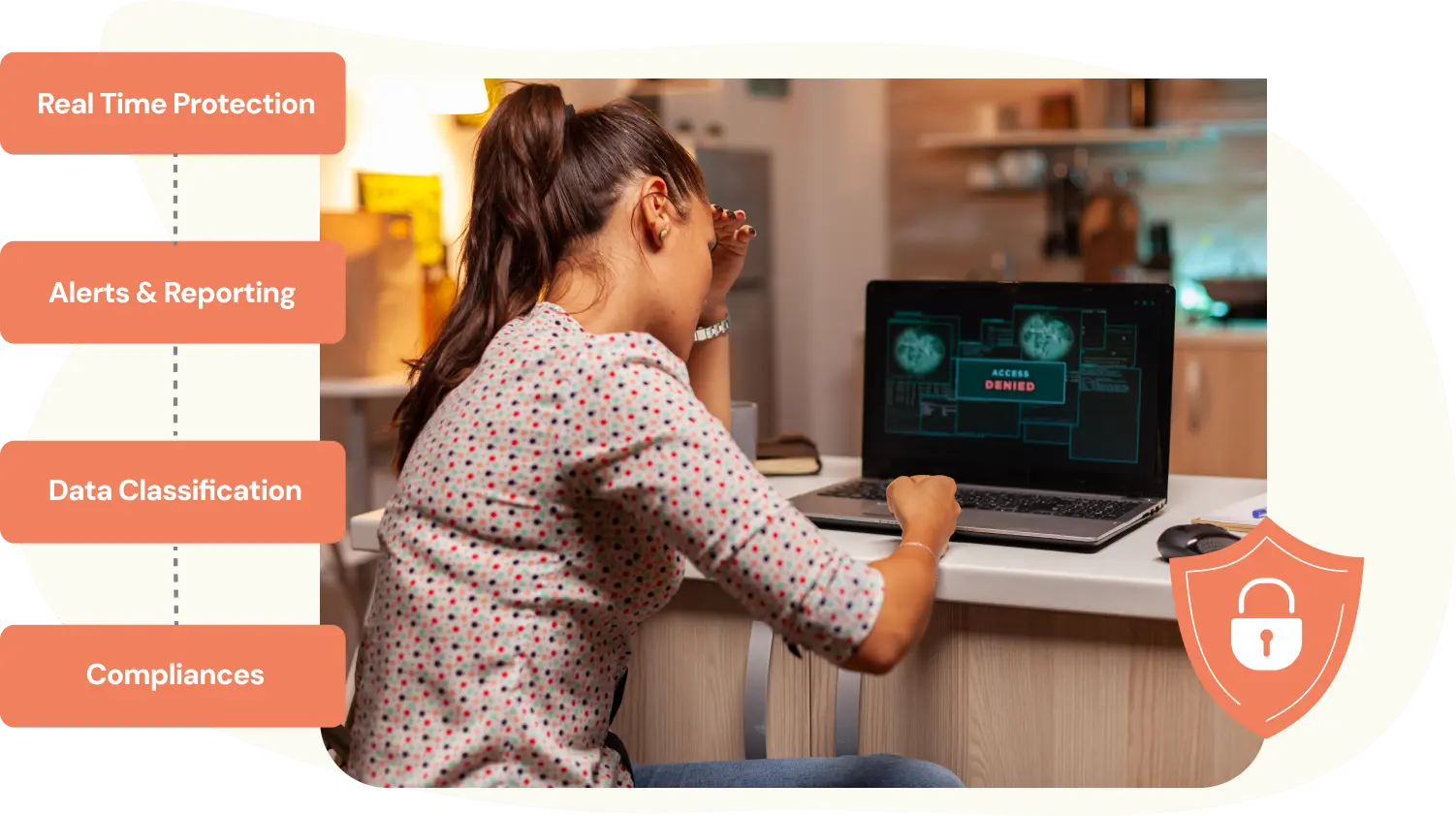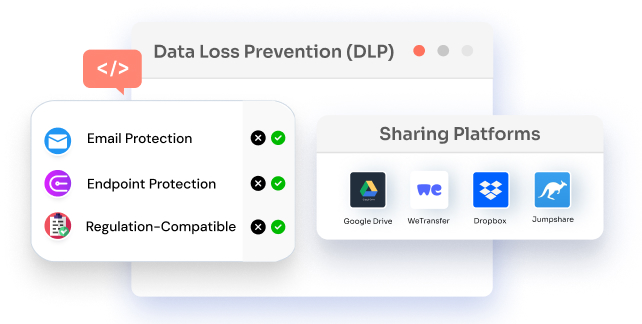Introduction
Hybrid work is now the norm, with many companies embracing this strategy to hire global talent and expand their business reach. However, when employees access company resources from multiple places, it’s important to have control over who gets access to what and how they use it.
So, the big question is: How do businesses keep their sensitive data secure in a hybrid work model?
One smart way to protect your data is by setting user restrictions and permissions on company-owned devices.
But how to do this?
In this blog, we’ll walk you through practical ways to restrict access on hybrid work devices and explain how Data Loss Prevention (DLP) tools can be your best bet for keeping sensitive information safe in a hybrid work setup.
What Are the Security Risks of Hybrid Working?
Let’s face it—hybrid work has its perks, but it also introduces some serious security risks. With employees working both from home and the office, these devices are exposed to higher risks of getting lost, stolen, or accessed by the wrong people. These devices connect to both secure office networks and less secure home Wi-Fi, which opens the door to threats like malware or ransomware attacks.
Another big concern is intellectual property (IP). When employees work remotely on sensitive projects, companies need to protect their data by limiting access. Setting access restrictions like that offered by DLP solutions can prevent unauthorized users from installing harmful software or connecting compromised devices to the company’s systems.
On top of that, access controls help you stay compliant with data protection laws like GDPR, HIPAA, or PCI-DSS. They ensure only the right people handle sensitive data. For instance, if an employee’s laptop with important files goes missing, access restrictions reduce the risk of a data breach. It’s all about making sure your business stays safe, compliant, and running smoothly—whether your team is working from the office, home, or anywhere in between.
Why do organizations need DLP USB blocking?
When it comes to data security, every person in an organization can be a potential risk. USB data leaks are one of the easiest ways insiders can steal critical information. Whether it’s an accidental mistake or a malicious act, anyone inside the organization can use a USB device to transfer important data from a company, causing serious harm to a company’s reputation and client trust.
For example, an insider threat can launch a BadUSB attack where a malicious USB injects harmful software into your network. This can be prevented using endpoint protector USB blockers like DLP solutions that stop unauthorized USB devices from connecting to company systems.
How Does DLP Solution Secure Business Data?
Data Loss Prevention (DLP) is a powerful tool for securing your company’s sensitive information, especially as remote and hybrid work becomes the norm. It monitors how data is shared, accessed, and sent across devices and networks.
With DLP, admins can set rules and policies to prevent confidential information from slipping out accidentally or being accessed by the wrong people. It ensures that important data stays within the company’s control—no leaks, no risks.
How DLP Works?
1. Monitor Data Flows : DLP solutions continuously track how data moves across networks, devices, and cloud environments. Whether files are being emailed, downloaded, or shared internally, the system scans for sensitive information—like personal data, financial records, or intellectual property—in real-time. This helps catch potential risks before they escalate, giving administrators visibility into how data is handled.
2. Set Restrictions : Admins can set up specific rules or policies to control how data is shared and used. For example, they might block employees from sending confidential documents to personal email accounts or uploading sensitive files to unapproved cloud platforms. These rules can be customized based on the type of data, the user’s role, or where the data is being sent, ensuring only authorized actions are allowed.
3. Prevent Data Breaches : DLP systems act as gatekeepers, blocking unauthorized attempts to transfer sensitive information through unsafe channels. This can include stopping data from being shared through instant messaging apps or external USB drives. By enforcing these restrictions, DLP helps maintain compliance with company policies and regulatory standards, reducing the chances of a data breach or accidental exposure.
Benefits of DLP Solution:
1. Real-time Protection : DLP solutions monitor your data 24/7 to detect suspicious activities as they happen. Whether it’s an employee accidentally sharing confidential information or a hacker trying to steal data, the system takes immediate action to block or quarantine the threat. This proactive approach helps prevent data breaches before any damage is done.
2. Compliance : Regulations like GDPR, HIPAA, and CCPA have strict rules about how sensitive data is handled and shared. DLP tools help ensure that your business complies with these laws by monitoring data flows and blocking any unauthorized sharing. This reduces the risk of non-compliance fines and keeps your reputation intact with customers and partners.
3. Data Classification : Not all data is created equal. DLP tools can identify and categorize sensitive information, such as personal customer data, intellectual property, or financial records. This ensures that high-priority information gets the protection it deserves and helps your team understand where your most valuable data resides.
4. Alerts and Reporting : If someone tries to move, share, or access restricted data, DLP tools immediately send alerts to administrators. Detailed reports provide insights into what happened, when, and who was involved. This visibility not only helps with a quick incident response but also provides valuable information for refining data protection policies.
Use Case: Securing Data in Hybrid Work
- Let’s say an employee is working from home and tries to upload a file containing sensitive customer data—like credit card numbers or personal information—to a third-party service such as Google Drive.
- This is where a Data Loss Prevention (DLP) solution comes in. As the file is being uploaded, the DLP system scans its contents in real time. If it detects sensitive information, it immediately blocks the upload.
- The employee gets notified with a message explaining why the action was blocked, helping them understand the risks involved. Simultaneously, the IT team is alerted, allowing them to investigate and take any necessary actions, such as reaching out to the employee or reviewing internal processes.
- In simple terms, the DLP solution prevents confidential information from being shared accidentally or intentionally, reducing the risk of data breaches or leaks. This proactive approach is crucial, especially in a hybrid work environment where employees often access and share data from multiple locations and devices.
Conclusion
Protecting your business data means limiting access to company devices. Data Loss Prevention (DLP) is the ideal tool for this, as it combines things like device-based authentication, MFA, and IP restrictions, allowing admins to build a secure setup for both remote and hybrid employees. With these strategies in place, your business can stay ahead of new cybersecurity threats without sacrificing data security.
Ready to secure your hybrid workforce?
Try the miniOrange DLP solution that seamlessly protects your sensitive information in both remote and hybrid environments. Contact us at dlpsupport@xecurify.com to get started today!
Additional Resources
1. CASB vs DLP: Understanding the Differences
2. Data Loss Prevention for Confluence - Protect Personal Information
3. Data Loss Prevention For Email | DLP Solution
4. USB Blocking and Endpoint Protection with DLP
5. Mobile Device Management (MDM) solutions
6. Android Mobile Device Management (MDM)
7. Top 10 Benefits of Mobile Device Management (MDM) for Businesses
Author




Leave a Comment